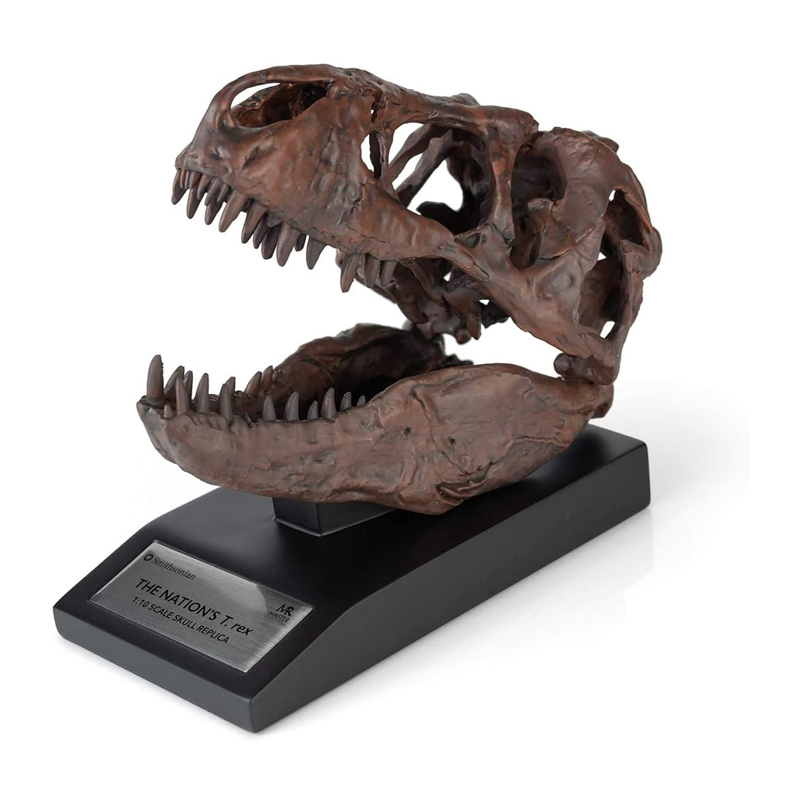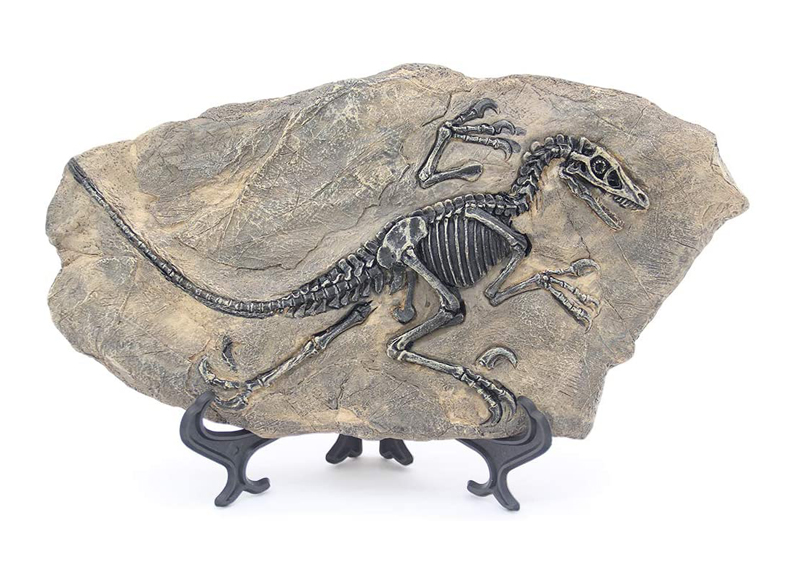Tyrannosaurus Rex’s Smithsonian Fossil Skull Replica Statue
The legendary Tyrannosaurus Rex is one of the most popular dinosaurs in the world. With terrifying jaws and an immense size, this large carnivore has a collectible appeal to any dinosaur enthusiast. Housed inside of the Smithsonian resides the specimen USNM 555000 T-Rex Skull. This fossil is known as the Nation’s T-Rex as it is the largest and most complete T-Rex skeleton specimens ever discovered. Now you can take home a piece of this prehistoric treasure. Durably constructed with a heavyweight polystone resin, it is designed to last a lifetime and features hand-painted detailing. A 1:10 replica, this impressive skull replica leaves a big impact in a small desk-sized space. Secured to a base and plaque, it displaying information about the skull, fastened on a display plaque featuring information about the actual specimen. Full authorized and licensed by the Smithsonian Museum, this T-Rex replica skull is ideal for anyone fascinated by the Tyrannosaurus Rex.
Tyrannosaurus is a genus of tyrannosaurid theropod dinosaur. The species Tyrannosaurus Rex (rex meaning “king” in Latin), often called T. rex or colloquially T-Rex, is one of the best represented of these large theropods. Tyrannosaurus lived throughout what is now western North America, on what was then an island continent known as Laramidia. Tyrannosaurus had a much wider range than other tyrannosaurids. Fossils are found in a variety of rock formations dating to the Maastrichtian age of the Upper Cretaceous period, 68 to 66 million years ago. It was the last known member of the tyrannosaurids and among the last non-avian dinosaurs to exist before the Cretaceous-Paleogene extinction event. Like other tyrannosaurids, Tyrannosaurus was a bipedal carnivore with a massive skull balanced by a long, heavy tail. Relative to its large and powerful hind limbs, the forelimbs of Tyrannosaurus were short but unusually powerful for their size, and they had 2 clawed digits.
The most complete specimen measures up to 12.3 meters (40 feet) in length, though T-rex could grow to lengths of over 12.3 m (40 ft), up to 3.96 m (13 ft) tall at the hips, and according to most modern estimates 6 tons to 8 tons in weight. Although other theropods rivaled or exceeded Tyrannosaurus Rex in size, it is still among the largest known land predators and is estimated to have exerted the strongest bite force among all terrestrial animals. By far the largest carnivore in its environment, Tyrannosaurus rex was most likely an apex predator, preying upon hadrosaurs, juvenile armored herbivores like ceratopsians and ankylosaurs, and possibly sauropods. Some experts have suggested the dinosaur was primarily a scavenger. The question of whether Tyrannosaurus was an apex predator or a pure scavenger was among the longest debates in paleontology.
Most paleontologists today accept that Tyrannosaurus was both an active predator and a scavenger. Specimens of Tyrannosaurus Rex include some that are nearly complete skeletons. Soft tissue and proteins have been reported in at least one of these specimens. The abundance of fossil material has allowed significant research into many aspects of its biology, including its life history and biomechanics. The feeding habits, physiology, and potential speed of Tyrannosaurus rex are a few subjects of debate. Its taxonomy is also controversial, as some scientists consider Tarbosaurus Bataar from Asia to be a second Tyrannosaurus species, while others maintain Tarbosaurus is a separate genus. Several other genera of North American tyrannosaurids have also been synonymized with Tyrannosaurus. As the archetypal theropod, Tyrannosaurus has been one of the best-known dinosaurs since the early 20th century and has been featured in film, advertising, postal stamps, and many other media.
T-rex was one of the largest land carnivores of all time. One of the largest and the most complete specimens, nicknamed Sue (FMNH PR2081), is located at the Field Museum of Natural History. Sue measured 12.3-12.8 meters (40-42 ft) long, was 3.66 meters (12 ft) tall at the hips, and according to the most recent studies, using a variety of techniques, estimated to have weighed between 6 tons to 8 tons. A specimen nicknamed Scotty (RSM P2523.8), located at the Royal Saskatchewan Museum, is reported to measure 13 m (43 ft) in length. Using a mass estimation technique that extrapolates from the circumference of the femur, Scotty was estimated as the largest known specimen at 9 tons in weight. Not every adult Tyrannosaurus specimen recovered is as big. Historically average adult mass estimates have varied widely over the years, from as low as 4.5 tons, to more than 7.2 tons, with most modern estimates ranging between 5.4 tons and 8.0 tons.
The largest known Tyrannosaurus Rex skull is 1.52 meters (5 ft) in length. Large fenestrae (openings) in the skull reduced weight, as in all carnivorous theropods. In other respects Tyrannosaurus’s skull was significantly different from those of large non-tyrannosaurid theropods. It was extremely wide at the rear but had a narrow snout, allowing unusually good binocular vision. The skull bones were massive and the nasals and some other bones were fused, preventing movement between them, but many were pneumatized (contained a “honeycomb” of tiny air spaces) and thus lighter. These and other skull-strengthening features are part of the tyrannosaurid trend towards an increasingly powerful bite, which easily surpassed that of all non-tyrannosaurids. The tip of the upper jaw was U-shaped (most non-tyrannosauroid carnivores had V-shaped upper jaws), which increased the amount of tissue and bone a tyrannosaur could rip out with one bite, although it also increased the stresses on the front teeth. Tyrannosaurus Rex’s Smithsonian Fossil Skull Replica Statue sizes: 8.1 inches / 20.5 cm x 8.1 inches / 20.5 cm x 8.1 inches / 20.5 cm.
Tyrannosaurus Rex Skull Statue on Amazon.
Tyrannosaurus Rex Skull Statue on eBay.
Dinosaurs Statues, Skulls Statues and Fossils Statues.





You must be logged in to post a comment.